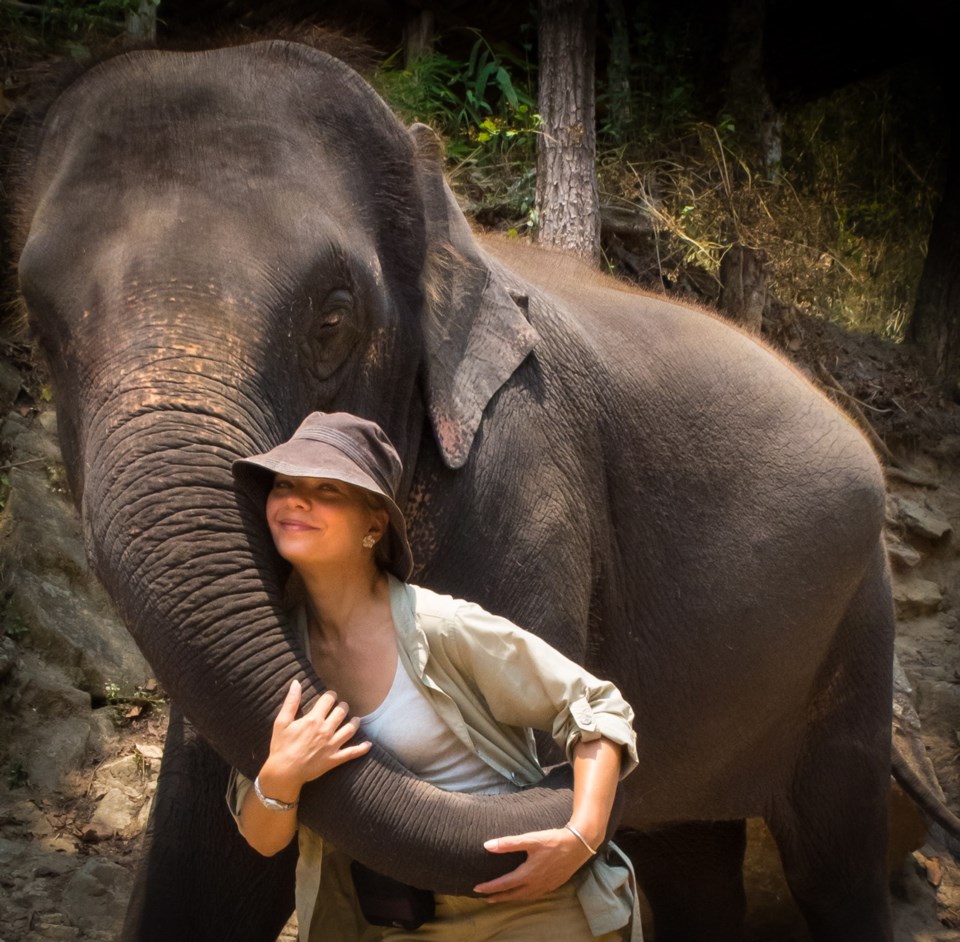Times Colonist movie writer Michael D. Reid is covering the Victoria Film Festival. Go to timescolonist.com./VFF for daily updates. Ratings are out of five stars.
When Patricia Sims and Michael Clark began documenting the plight of endangered Asian elephants in Thailand in 2010, they never imagined their passion project would take six years instead of six weeks.
And they certainly didn’t realize they wouldn’t just be making a film, but actually living it — and almost dying at one point — before having to adapt to changing circumstances during production.
The Victoria-based filmmakers will participate in a Q&A after their labour of love, When Elephants Were Young, screens tonight at 6:30 p.m. at Cineplex Odeon.
“Does the human take care of the elephant, or does the elephant take care of the human?” a retired elephant catcher wonders onscreen, underscoring this outstanding documentary’s message.
The film, narrated by William Shatner, initially captivates you because of the magnificence and mystery of its title creatures.
It also features insights from elephant experts as the filmmakers explore the complex relationship between elephants and humans. While observing the bond between Wok, a young mahout, and Nong Mai, the elephant he has cared for since she was three, they pull the bigger picture into sharp focus — notably the sacred place elephants occupy in Asian culture, and their endangerment.
“You could not write the story that happened to us,” says Clark, the cinematographer, editor and music supervisor who co-wrote the film with Sims, its director.
“The landscape was changing, and we had to change with it. We realized we were meant to be there.”
The filmmakers couldn’t overlook unexpected developments about Nong Mai’s potential fate, for instance. Nor did they realize how complex human-elephant relations had become, with more changes ahead.
Wok’s admission that selling sugar cane to tourists while illegally street-begging with Nong Mai in Bangkok “makes me feel dead inside” was one surprising revelation.
Continuing a tradition that can earn the elephant and her keeper about $200 a night is something Wok, 26, feels obligated to do to support his debt-ridden family, however, numbing the pain with alcohol.
His bond with his elephant, whom he lovingly washes and plays with in some of the film’s most joyous sequences, is challenged, however, for compelling reasons.
“As much as we think we know about Asian elephants, I think they also know things about us,” says Sims, who believes there’s an element of “collective memory” and that elephants can understand people.
“When Nong Mai was first with Wok they were both kind of babies,” she says. “It’s like co-dependency. I compare it to a bad marriage. We can’t know how an elephant feels about the mahout, but it seems like a love-hate thing.”
Sobering statistics augment the film’s dramatic developments. As bizarre as it sounds, we learn that while elephants are an endangered species in Thailand, 90 per cent are privately owned. We also learn there are fewer than 45,000 Asian elephants left on Earth; that most elephants in Thailand are forced into its $40-billion-a-year tourist trade; and that only 4,000 remain there, 2,800 in captivity.
When Elephants Were Young is no mere catalogue of gloom, however. The Elephant Reintroduction Foundation, which aims to return captive elephants to the wild and protect habitats, plays a starring role.
The initiative of Thailand’s Queen Sirikit and the Royal Forestry Habitat granted Sims and Clark access to these forest sanctuaries, where filming had never been permitted.
It was while driving to one, the Sublangka Wildlife Sanctuary, to film newborn wild elephants in the summer of 2014, the filmmakers had their near-death experience.
After their vehicle was hit on a mountain highway, it plunged 120 metres over a cliff before being caught by a tree that stopped it from plummeting further.
Clark and the driver had cuts and bruises, but Sims suffered broken ribs, herniated discs and internal injuries.
“When you’re in the middle of a story like this, it becomes your life,” says Sims, who admits she has been addicted to elephants since she read a scientific study suggesting they have self-awareness.
Indeed, it was the foundation’s work that inspired Sims to become co-founder of World Elephant Day.
“The fact they let us into this world, and that we were able to be part of it, experiencing it in real time was amazing,” Clark adds.
One of the film’s strongest assets is its narration by Shatner, who also narrated the duo’s shorter 2012 documentary Return to the Forest.
“He has a very big heart and is very much into animal advocacy,” says Sims, who called Shatner after reading a foreword he wrote for the book Kinship With Animals and learning that in 2009, he had joined a chorus of Canadians including Margaret Atwood and Michael Ondaatje, who urged Edmonton’s city council to move Lucy, the aging captive Asian elephant, from city-run Valley Zoo.
“Most people don’t know William Shatner for his real dramatic talent. He has this whole other persona.”



